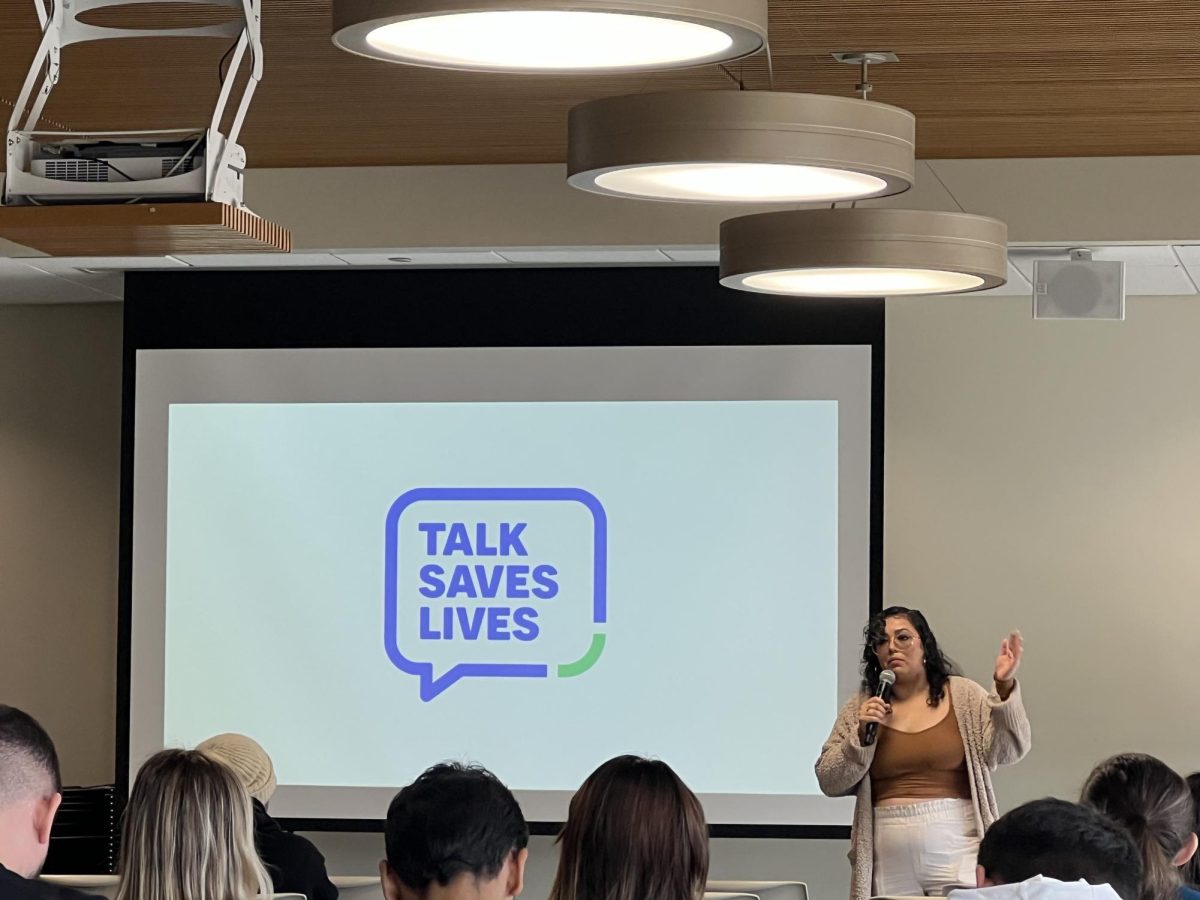Elgin Community College hosted a suicide prevention awareness event in B180 on Sept. 20, 2023. 28 people of a wide age range were in attendance.
The event included a 45-minute presentation titled ‘Talk Saves Lives’ by Programs Manager for the Illinois chapter of the American Foundation of Suicide Prevention Luma Bonilla-Webster.
It covered topics such as understanding the scope of the problem of suicide, explaining key suicide research findings, describing suicide risk factors and warning signs, how to seek support for yourself and others and how to access crisis resources.
According to Bonilla-Webster, the AFSP does not provide direct crisis services, as they focus more on educating people and research.
“Suicide is a complex health issue, and it can often be prevented,” Bonilla-Webster said. “Just like there are warning signs and risk factors for other health issues—for example, cardiac arrest—we want to learn what the risk factors and warning signs are for someone who is in a suicidal crisis.”
Starting intervention early with someone who is at risk for suicide is important, just like it is for other health problems.
“A life can be saved if you allow time,” Bonilla-Webster said. “Time for a person’s suicidal risk to subside, and time for them to be connected with the help and assistance that they need.”
Bonilla-Webster went on to talk about the dos and don’ts when it comes to the language regarding suicide, which can help end stigmas.
Avoid saying that someone ‘committed’ suicide, since the word ‘committed’ has a negative connotation. Also avoid saying that someone ‘failed’ or was ‘successful’ in committing suicide, as Bonilla-Webster says there is no such thing. Instead, say ‘died by suicide,’ ‘ended their life’ or ‘killed themselves.’
Over 700,000 people die by suicide in the United States every year, according to the World Health Organization. That equals roughly one person every 40 seconds. The numbers of those who attempt suicide are even higher.
“For every suicide, 25 others attempt,” Bonilla-Webster said. “That’s well over a million Americans who survive a suicide attempt each year.”
Bonilla-Webster moved on to discuss why people take their own lives. She says there is no one cause, but that underlying mental health conditions often play a role.
“Research has consistently shown that the large majority of people who die by suicide had a mental health condition at the time of their death,” Bonilla-Webster said.
However, mental health conditions don’t paint the entire picture.
“The brains of people who die by suicide differ from those who die from other causes,” Bonilla-Webster said. “And here we’re looking at the structure and function, specifically the areas [of the brain] related to stress response and impulse control.”
According to Bonilla-Webster, research has shown that most people who are suicidal are ambivalent about taking their life. There is a part of their brain that wants them to die, but also one that wants them to live. The goal is to better connect them to the part that wants them to live.
A suicidal person is at a point of crisis where they are desperate to escape the pain. Bonilla-Webster asks the audience to take a moment and think about the most intense physical pain they have ever experienced.
“At that moment, would you have been able to give someone directions to your home,” Bonilla-Webster said. “Would you have been able to accurately explain to them what is going on and why you are feeling pain?”
Almost every single person in the room shook their heads in unison.
“The pain makes ordinary thinking impossible,” Bonilla-Webster said. “Someone who considers suicide cannot foresee a time in the future where that pain will end.”
Bonilla-Webster then moved on to discussing risk factors that can converge and increase a person’s risk for suicidal behavior, including health, historical and environmental factors.
Health factors include depression, anxiety, bipolar disorder, substance use disorders, and chronic or serious physical health conditions.
Historical factors include a family history of suicide, childhood abuse, loss, and previous suicide attempts.
Environmental factors are circumstances in a person’s life. These include access to lethal means (the most common being firearms), exposure to another person’s suicide or graphic accounts of suicide, prolonged stress, harassment and bullying, relationship problems or other life events.
The next section of the presentation shifted to discussing how suicide can be prevented.
According to Bonilla-Webster, protective factors can include proactively taking care of your mental health, strong support from friends and family, problem-solving skills and cultural or religious beliefs that can create a strong sense of purpose.
“One of the biggest challenges in fighting suicide is getting people to address their mental health in the same way that we address our physical health,” Bonilla-Webster said. “If you were having pain in your leg or in your chest, you would go get that treated. If you are recognizing that you are having suicidal thoughts, you should immediately get yourself treated.”
The law requires insurance to cover mental health services the same as they cover physical health services.
Bonilla-Webster then reiterates the vital role that time plays in helping a suicidal person.
“The most important thing you can put between a suicidal person and their way of ending their life is time,” Bonilla-Webster said. “By temporarily reducing a suicidal person’s access to lethal means, we give suicidal individuals time for the intense suicidal risk to diminish… and time for someone to intervene with mental health support and resources.”
According to Bonilla-Webster, having a conversation with a person in need is vital.
“It’s important to have a caring, supportive conversation with someone you might be worried about to allow them to share what they are experiencing,” Bonilla-Webster said. “Having a conversation shows them that you care and allows you to gain more information about why they are in distress.”
She then goes on to discuss warning signs, which she says can display themselves over a longer period of time.
Suicide warning signs are typically displayed in three main ways: talk, behavior and mood.
“People who are suicidal will often tell you,” Bonilla-Webster said. “They will talk. This may be directly or indirectly. They may say it outright or they may even joke about it. We always want to take the conversation seriously.
Bonilla-Webster explained that some of these atypical behaviors may be increased by a multitude of factors, including the use of drugs and alcohol, underlying issues with insomnia and/or over-sleeping, reckless decisions, withdrawing from activities that were previously enjoyable, isolation from friends and loved ones, or the act of giving away possessions.
“People at risk for suicide can often display sudden changes in mood,” Bonilla-Webster said. “Depression, apathy, rage, irritability, humiliation, anxiety. Another often unknown one is sudden, unexplained happiness. Happiness can indicate that the individual has decided on a [suicide] plan… and are relieved that they will no longer be in pain.”
She stresses that you must always assume you are the only one who is going to reach out to someone regarding concern for their safety.
There are also some things you should avoid when it comes to addressing these concerns with someone.
“Avoid minimizing their feelings,” Bonilla-Webster said. “Avoid trying to convince them that life is worth living. If someone is nearing a crisis point, they are not thinking clearly. Avoid offering advice on how to fix it. If a person was having a heart attack, you wouldn’t tell them to start exercising or eat a healthier diet.”
So what should you do then?
“Talk to the person in private,” Bonilla-Webster said. “Listen to their story. Allow them to talk for as long as possible. As we’ve been saying, the key point here is giving time for the intense suicidal risk to decrease. Express concern and caring through active listening.”
Asking them about their specific plans for suicide can also help secure lethal means. If someone says they plan to shoot themselves, securing or removing the ammunition from firearms is an example of how to secure the lethal means.
If intervening in a suicidal crisis could be dangerous, you should call 911, although Bonilla-Webster says you should ask for a crisis intervention-trained specialist especially if the person in crisis is a person of color.
“In Illinois, not every county has [a crisis intervention specialist],” Bonilla-Webster said. “So you have to ask… they can come with police to answer a mental health call.”
Bonilla-Webster then ended the presentation by summing up its main point.
“Together, we can create a culture that is smart about mental health and suicide prevention,” Bonilla-Webster said.
Anyone who is or knows someone who is experiencing a suicidal crisis is encouraged to call the Suicide and Crisis Lifeline at 988.







